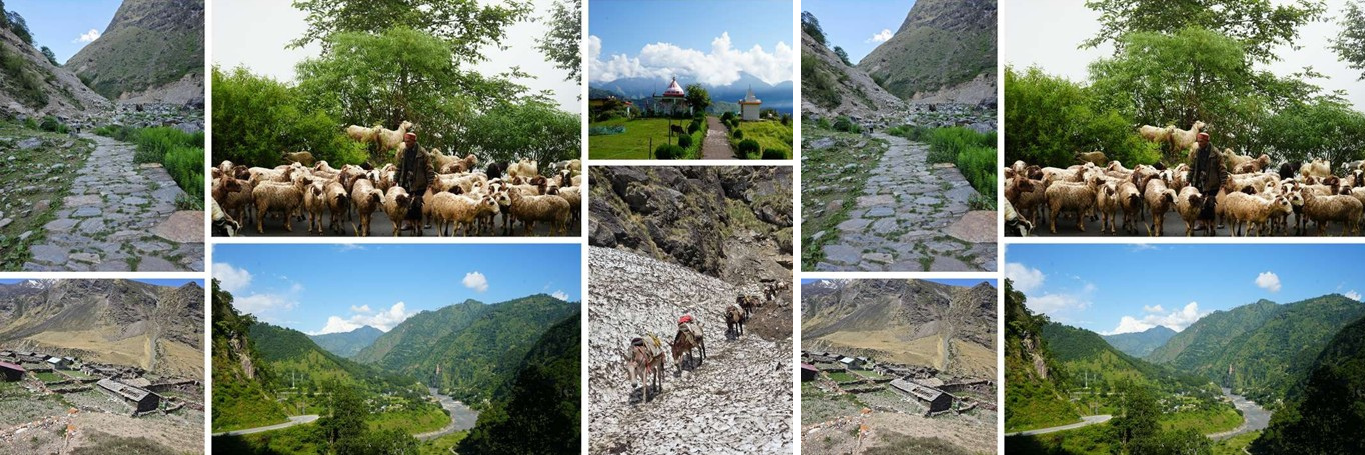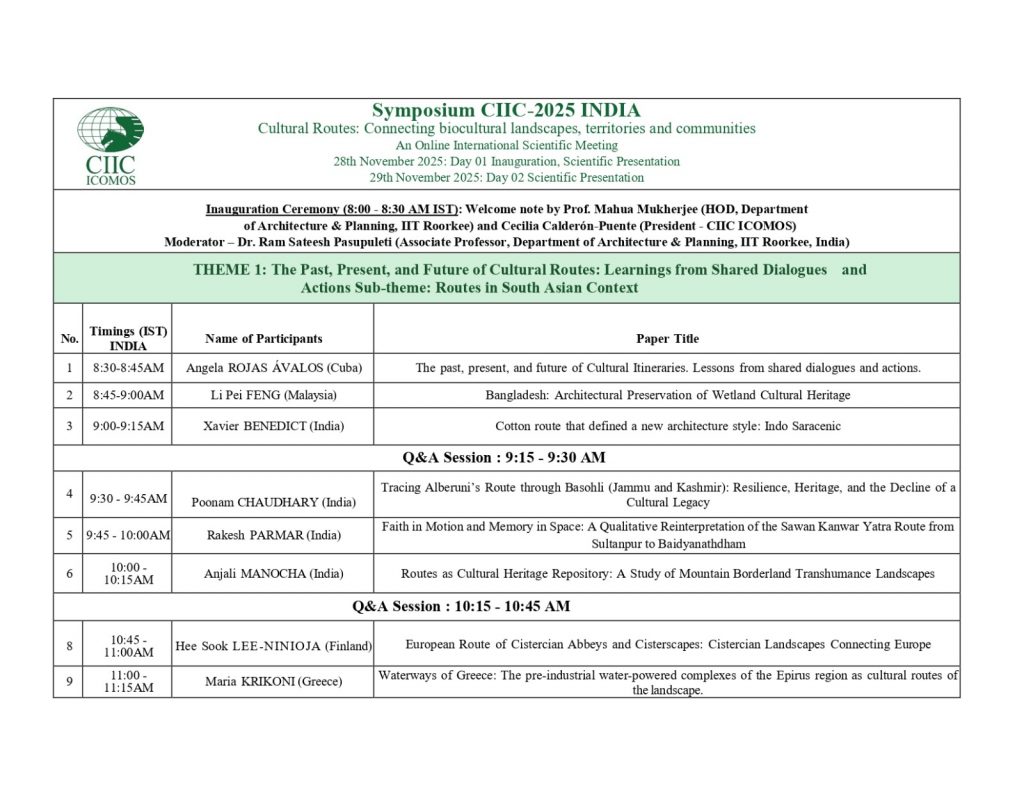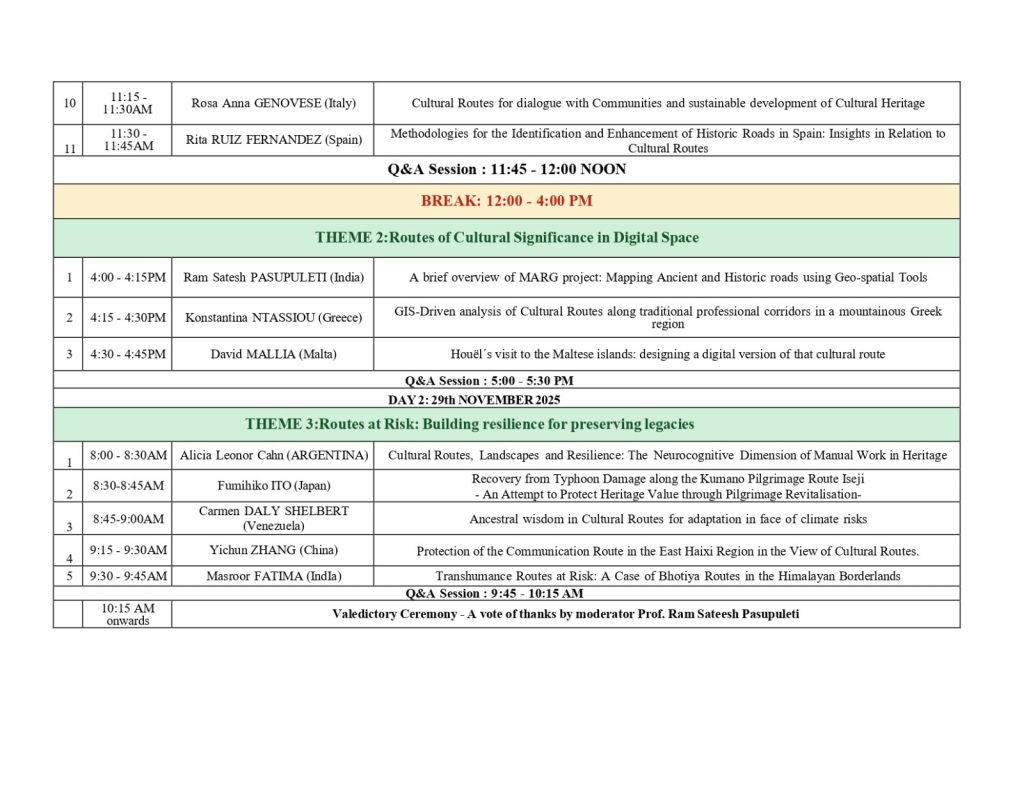
CIIC 2025
Cultural Routes: Connecting biocultural landscapes, territories and communities
An Online International Scientific Meeting
28th November 2025: Day 01 Inauguration, Scientific Presentation
29th November 2025: Day 02 Scientific Presentation
Organized by- Civic Design Lab, IIT Roorkee


The International Committee of Cultural Routes (CIIC) is one of the International Scientific Committees of the International Council on Monuments and Sites (ICOMOS) dedicated to the conservation of the world monuments and sites. Following the submission and subsequent nomination of the Camino de Santiago as World Heritage Site in 1993, International Committee on Cultural Routes (CIIC) was created by a group of ICOMOS members representing diverse regions. These members took on the task of outlining and defining this new category of heritage in order to establish a methodology appropriate to the meaning of this concept. As a result of their intense efforts and a long process of international consultation, the CIIC has developed a definition and methodology, which are reflected in its Charter on Cultural Routes, ratified by the 16th General Assembly of ICOMOS, in Quebec (Canada), in October 4, 2008. So far more than thirty scientific meetings focusing on cultural routes were held in different countries and places of heritage interest. Following the recent scientific meetings held in Santa Fe, USA, and Florence and Ravello Italy, and the ongoing CIIC 2024 virtual meetings, the Department of Architecture and Planning, Indian Institute of Technology Roorkee is now planning to host the Scientific meeting of CIIC-2025 in Late November 2025.
Brief about CIIC-2025
Main theme: Cultural Routes and Beyond: Mediating humanized landscapes
The dynamic relationship between the routes and their territory they traverse correlates with humans and their transforming environment. As humans walked upon these routes (in the past), they reciprocated in the form of spatial impressions. These impressions, over time, became cultural resources for later generations. Regardless of the objectives these routes served –trade, pilgrimage, transhumance, among others-, they went beyond the mere act of movement and transfer of goods. These routes are the facilitators of culture, knowledge, and ideas shaping our current landscape.
These cultural routes reflect multi-layered meanings concerning their associated spaces. As Henry Lefebvre in The Production of Space suggested, concepts of space can be of three types: conceived, perceived, and lived. Thus, it can be argued that when historic routes were walked upon, it was a conceived space for travelers as it was created with their knowledge. It later became a perceived space owing to various cultural practices and the involvement of social groups. With repeated encounters, these spaces can be comprehended as lived spaces. In the current scenario, when these routes are vulnerable and contested due to the transforming needs of society, they have become differential spaces. These insights show how the landscape over the years has been humanized to make way for cultural routes.
The scientific meeting explores how cultural routes behave, how they are affected by their environment, and how they can be safeguarded for future generations in association with their landscapes. With the ever-evolving discourse on heritage, this scientific meeting becomes significant for the study of cultural routes and biocultural territory, as both have a strong influence on each other.
The scientific meeting of the International Scientific Committee on Cultural Routes (CIIC) of ICOMOS will be held from 28th to 29th November 2025 at the Department of Architecture and Planning, Indian Institute of Technology, Roorkee, Uttarakhand. The scientific meeting will be focused on the following three themes.
THEMES OVERVIEW
Theme 1.
The Past, Present, and Future of Cultural Routes: Learnings from Shared dialogues and Actions
Cultural routes are connected through the threads of people’s memories and experiences, woven into the carpet of the past and present across diverse cultural landscapes. As academicians and professional experts, it is our role to link these threads to the future to safeguard them. Historically, these routes were used for trade, the exchange of ideas, traditions, politics, and religion, which facilitated the growth and fall of civilizations. The more they are explored, the more they unveil the complex interplay of traditions. Today, these cultural routes stand as testimony to shared heritage across borders and continue to be significant in contemporary heritage discourses. By engaging academicians and stakeholders through shared dialogues and actions, we can ensure that these routes of the past remain relevant to the current and future generations. This theme involves discussing the potential initiatives and challenges across different parts of the world associated with Cultural Routes to promote interconnection among people and mutual respect.
Sub-theme: Routes in South Asian Context
This sub-theme will particularly discuss routes in the South Asian context. As it has been observed that along with the Silk Route, and Grand Trunk Road in South Asia, there are routes that hold significant potential for being Cultural Routes for its significant heritage values. This theme may include specific case studies of South Asia, theoretical or frameworks, to highlight the significance of cultural routes in shaping South Asian identity globally.
Theme 2.
Routes of Cultural Significance in Digital Space
Cultural Routes have long served as pathways for exchange, pilgrimage, and exploration, weaving together the threads of history, tradition, and landscape. There is a growing demand for the digitization of cultural heritage data, which is further intensified due to the pandemic. Today, digital space offers exciting opportunities to transcend physical limitations and reimagine these routes for a global audience. This theme delves into how digital tools are revolutionizing how we experience, understand and preserve these cultural and significant historic roads.
Through interactive online platforms that bridge the physical and digital, users can embark on self-guided journeys along the routes, immersing themselves in recreated environments along with interactive storytelling. This allows for a more inclusive and accessible experience, reaching audiences who may be geographically distant or have physical limitations.
Digital preservation plays a crucial role in safeguarding cultural heritage. Ongoing impacts of climate change or human interventions have compromised their presence in the physical world. By creating high-resolution scans and detailed records of historic sites that represent tangible aspects followed by their intangible associations, and by creating digital multi-layered inventory systems with a uniform metadata schema for cultural heritage institutions, we can help them manage cultural routes.
Considering the challenges presented by digital space, issues of information accessibility and digital literacy need to be addressed to ensure equitable access to these resources. Furthermore, the vast volume of information available online necessitates robust curation strategies to ensure the authenticity and accuracy of content.
This theme invites a thoughtful discussion about harnessing the power of the digital space for understanding cultural routes from a different perspective. By promoting innovation, inclusion, and collaborative practices, it ensures that these historical journeys continue to inspire future generations and connect us with the rich tapestry of human experience.
Theme 3:
Routes at Risk: Building resilience for preserving legacies
Over the last few decades, several new perspectives have been introduced in the field of cultural heritage and one of them is cultural routes being extensively explored by various institutions. Cultural routes include not only tangible cultural assets and physical communication routes, but also intercultural dialogues across boundaries. They possess a sea of cultural elements accumulated over the years, enhancing the significant cultural value of the place.
However, several routes have lost their identity due to political issues, economic preferences, natural disasters, haphazard urban development, and a lack of awareness regarding their protection. In the context of South Asia, the routes are of different scales, situated at different physiographic settings, and among multiple political boundaries. These routes integrate different typologies of heritage structures with associated tangible and intangible elements. This analyses cultural routes as more complex and establishes the need for necessary deliberations.
Exposure to one or more hazards may give rise to risks related to historic and cultural heritage. The cultural route consists of a blend of tangible and intangible elements wherein, tangible elements are physical structures like monuments, sites, pathways, and objects, and intangible elements are cultural assets like values, traditions, and associations. Thus, the catastrophic impacts of disasters on cultural routes are not only limited to physical entities but also increase the vulnerabilities of heritage values. Particularly, routes belonging to mountainous regions are extremely vulnerable to compounding and cascading hazard risks due to fragile topography, impacts of rapid climate change, and anthropogenic activities like unplanned urbanization and other developmental projects. The consequences of hazardous events are disruption of ecological relationships, and disappearance of local livelihoods, traditional skills, and cultural practices of the community. Institutions like ICIMOD, CDRI, NDMA are already working in the domain of climate change and disaster risks in the Himalayan region to combat the multiple disaster risks in the Himalayan region. Further, there is a need to exaggerate the importance of community participation and the role of traditional knowledge systems for mitigating and adapting disaster risks prevailing in cultural significant routes.
The theme discusses the risks associated with the routes of cultural significance and the role of local communities and concerned stakeholders in building resilience towards disaster risks.
ARY OF THE EVENT AGENDA
Call for Abstracts : October 8, 2025
Abstract Submission Deadline : October 24, 2025
Acceptance Notification : October 31, 2025
Registration Opens : November 1, 2025
Full Paper Submission Deadline : November 21, 2025
Registration Closes : November 21, 2025
Conference Dates : November 28 and 29, 2025
DEADLINES
1. Sending presentation summaries
The deadline for submission of the presentation summary is Friday, October 24, 2025. The summaries must be sent to the email: ciicicomos.org@gmail.com
2. Publication of selected presentations and modality of participation
The authors of the selected presentations will receive a notification from Friday, October 31, 2025 by mail ciicicomos.org@gmail.com . The selected research to participate will be published.
3. Full Paper Submission Deadline
The authors of the selected presentations will have the limit to send their presentations in length on Friday November 21, 2025, the material and the verification of the payment of their access to the event, must be sent to the mail ciicicomos.org@gmail.com
The presentations in length, will have 15 minutes, at the end of each panel will be held a feedback session and questions with a duration of 15 minutes.
4. Registration for the Scientific Meeting, Transportation, Lodging and Travel
The scientific meeting will be held remotely. In case any of the participants wish to attend in person, the transport, lodging and all the travels of each of the participants: speakers or non-speakers, will be borne by themselves.
5. Registration fee
- CIIC Members: Free of Cost
- Non- Members:
- For Presentation & Publication: $100USDll (American dollar)*
*Consider that you may pay at the CIIC account in Paris, and the charges for transfers between banks are your responsibility.
- For Attending Participants: Free access
6. Certificates of participation
Certificates of participation as a speaker will be given to the registered participants. The works must be submitted individually.
7. Rights
a) The presentations must be of their own authorship and when sent to the CIIC, the authors admit that they do not contain elements that may damage the intellectual property of a third party.
b) In sending the presentations, the rapporteur authorizes the International Committee on Cultural Routes (CIIC) so that such works may be exhibited, promoted, disseminated and/or published in any printed media, always including credits for authors for the purposes of education, promotion, dissemination and fundraising for all CIIC related activities.
c) The CIIC is a scientific committee of ICOMOS, without direct economic resources and its important work is made possible by its promoters, supporters and several independent sources of funding, including events such as congresses, conducting publications and fundraising from business sponsors.
d) Each author always retains his/her right of authorship over the work submitted and the information contained therein will always be recognized, announced, notified whenever his/her work is displayed or disclosed.
PRESENTATIONS
1. Summaries
Those interested in submitting a presentation should submit a summary in Word format (.docx) that does not exceed 500 words, 12-point Times Roman letter, simple leading, case-sensitive, in Spanish and English. All margins at 2.5cm., brief resume of the author that does not exceed 125 words.
The following data should be included before the summary:
- Thematic axis and sub-theme in which it records its summary
- Title and subtitle of the presentation
- Name of the author. Name in uppercase and lowercase. Last names in capital letters
- Five keywords
- Institution (University, Enterprise, Public Sector, Civil Organization, among others)
- Institution Membership or Position
- Address (state, city, country)
- Current phones and emails
Proposals should be sent to the ciicicomos.org@gmail.com mail by writing down in the case the first word of the thematic axis, the first word of the sub-item, followed by their surnames and at the end, the text: presentation2025.
Example: heritage-dignity_ENRIQUEZMARTINEZpresentation2025
To be included as speakers in length in the program of the CIIC Scientific Symposium 2025, the registration fee must be covered with the limit on Friday November 21, 2025.
Payments for speakers will be made to ICOMOS International CIIC Account and will be informed at the time of being accepted.
2. Selected lectures
The selected papers will be published in a chapter of the book of the Scientific Meeting and must meet the following editorial criteria:
a) Summary in Spanish and English adjusted to a maximum of 500 words. Five keywords
b) The text of the presentation may be presented in English, in Word format (.doc)
c) The text of the presentation will contain on the first page: title and subtitle of the presentation. Thematic axis and sub-theme Name of author. Name in uppercase and lowercase. Last names in uppercase letters. Institution. All centered.
d) Minimum length of 4,000 and up to 5,000 words letter sizes (8 to 10 pages), plus graphs, pictures, images -all with subtitles-, footnote quotes in Times Roman number 10 – no citations between the text – and references at the end of the document ordered alphabetically with full author names to avoid confusion. All according to UNE Standards 50-104 (ISO 690).
e) The entire document shall be written in Times Roman 12 simple, justified leading and total margins at 2.5cm.
f) Subtitles in Italic
g) Images like graphics or photographs used in the text must be included in the text, in a maximum definition of 300dpi in jpg or png format
Papers will be presented in English during the event.



